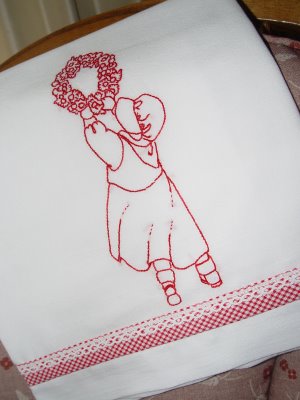 I am in the mood for redwork! It's a beautiful form of embroidery, especially for the holiday season. Not only is it pretty, but stitching redwork is quite simple and fast because you do not have to change thread colors, but can stitch away until your thread runs out!
I am in the mood for redwork! It's a beautiful form of embroidery, especially for the holiday season. Not only is it pretty, but stitching redwork is quite simple and fast because you do not have to change thread colors, but can stitch away until your thread runs out!A college friend is a designer of beautiful things, and has created an embroidery design for redwork called "Tea Party". Her pattern will be for sale soon, and while waiting for pattern publication I am inspired by a photo of her sample piece on her blog. I know a few of you are waiting along with me. Stitching on a chilly, winter evening is a relaxing event and I am looking forward to quiet, cozy times in front of a warm fire while I stitch. I'm eager for Fay's design, but in the meantime may start a few redwork tea towels while I wait. The winter is long enough for more than one embroidery project
Redwork is the art of embroidery using only one color: red. I used to think the idea was quite boring, as I tend to like selecting color families that work together in a project. But, recently I tried my hand at redwork and have enjoyed both the process and the cheerful finished sampler. The redwork tea towel in the picture above is one I recently embroidered for Val, a friend in the tea towel exchange group I belonged to.
Originally, red dyed cotton threads were not colorfast and the colors tended to bleed when they became wet. Embroiderers tended to select other colors or stitch red's in silk threads that would not bleed. Then a red dye was developed in Turkey that did not bleed or fade when washed. Soon, Turkey red thread became a reliable and popular choice for stitching decorative patterns on household items.
In 1876 The Royal School of Art Needlework from Kensington, England produced a booth at the Centennial Exposition in Philadelphia. American women were charmed by the intricate embroidery and were ready to try their hand at it. It soon gained popularity, as more and more stitchers created embroidered samplers and quilts using this process.
Redwork designs range from very simple to elaborate and intricate. Over time, pictures of nursery rhymes, people, buildings, animals, and flowers have been depicted in this art. In times past, squares of preprinted patterns were made available for redwork. These squares cost a penny apiece, thus the name penny squares became a common term when describing these blocks. Completed blocks were used for many household projects, but became especially useful and popular for bedcoverings. Blocks were sewn together and a feather stitch or cross-stitch was used to cover the seam line.
Stitches especially common when stitching redwork are backstitch, outline stitch, and the stem stitch. The stem stitch is also called the South Kensington stitch or the English Kensington stitch, a name that probably took hold because of the popularizing of this embroidery style by The Royal School of Art Needlework in 1876.

Red is my favorite color and I've long enjoyed rework. I am planning a few winter projects, something of this type would be a good one.
ReplyDeleteI saw recently on a blog where someone had made yo yo's from Christmas fabric and sewed them onto a lace doily. It was beautiful, that is what I'm starting first. :)
I too love redwork LaDonna!
ReplyDeleteI can't wait for some time to sit and do some redwork.
Thanks for sharing the wonderful link!
Wishing you a blessed Thanksgiving and week...
I love this! I had not heard of redwork as a name, but have admired it for certain!
ReplyDeleteRedwork tea towels are the perfect winter project. I love the designs of your friend and can't wait to see more.
ReplyDelete~Adrienne~
I really enjoy redwork, too, for all the reasons you suggest. I'd like bluework, greenwork or any color work, I'm sure. Love your header in all the snow...it looks so cozy. Have a wonderful week, my friend.
ReplyDeleteThanks for the history of redwork embroidery. I have always been fascinated by it. I think if I took up embroidery again I would love doing redwork. Now I must visit the link, I might just be tempted.
ReplyDelete